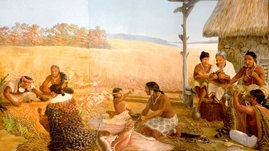Teachers' Domain - Digital Media for the Classroom and Professional Development
User: Preview


The scenes in this rollover interactive, adapted from a mural at the Wickliffe Mounds State Historic Site museum, depict typical village life of Native American Indians of the Mississippian culture. The village was occupied from 1100 AD until about 1350 AD. The Mississippians, as they are known today, built a complex settlement with houses and mounds situated around a central plaza on a natural bluff overlooking the Mississippi river surrounded by woodland forests.
The mural shows the Mississippian people participating in the day-to-day activities of late summer/early fall: building houses, processing food, making stone tools, tanning animal hides, and weaving.
Everything Mississippian people had came from their environment and was hand made. The Mississippians also wore clothing that was best suited to their climate and culture, according to their standards. They created clothing from leather made by tanning animal skins, also called hide, and then stretching the hides on wooden frames. After letting the hides dry, they would punch holes in the leather and sew it together with leather strips. Mississippians also wore fabric clothing also. They wove together plant fibers such as hemp, nettle, and the inner bark of the mulberry tree. The fibrous strings were hand woven into cloth and stained different colors using flowers and berries for dye. They also made capes and coats from feathers. Women, girls and little boys dressed very plainly and usually wore knee-length skirts made of woven plant fiber or leather, and held together at the waist with a finger-woven sash or belt in designs that represented their clan or had meaning to their family.
Native American Indians of the Mississippian culture ate a variety of foods that they hunted, fished, or trapped from the river’s edge and nearby woodland forests or that they planted and harvested. Mississippians were Kentucky's first full-time farmers and they grew corn, squash, legumes and pumpkins. They gathered all manner of plants, nuts, seeds, leaves, roots, berries and fruit from the woods. They also hunted the forests for game such as deer, turkey, geese, ducks, raccoons, bear, squirrels and rabbits. The river provided plentiful fish of all species, eels, turtles, frogs and mussels.
To build a house, or hut, Mississippian people used wooden posts, such as hickory wood, river cane or tree saplings, called “wattle”, and leather strips, because they had no nails or metal tools. They used wet clay to smooth over the wattle walls which formed “daub”. Mississippian style houses are called “wattle and daub” huts. These houses had a grass thatch roof made of native grasses such as Big Blue Stem, and dirt floors on the inside.
The only domesticated animal the Mississippians had was the dog. [Other American Indians domesticated horses, once horses were introduced by the Spaniards.] These dogs were a large breed similar in size to coyotes and wolves. While some dogs may have been pets, these dogs were usually working animals that helped guard the village from animals and raiding parties.
 Loading Standards
Loading Standards